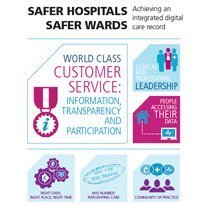NHS England has released guidance for trusts to achieve fully integrated digital care records across all care settings by 2018.
‘Safer Hospitals Safer Wards: Achieving an integrated digital care record‘ “sets out the benefits case for adopting safe digital record keeping as a precursor to achieving integrated digital care records across the health and care system."
It also gives full details on how trusts can get their hands on some of the new, £260m Safer Hospitals, Safer Wards Technology Fund and sets a deadline of 31 July for expressions of interest.
Health secretary Jeremy Hunt said in January this year that he wants to see a paperless NHS by 2018.
NHS England’s guidance goes a step further by saying its vision is for a fully integrated digital care record across all care settings by 2018.
It describes an IDCR as the ability of local health and care services to “use digital technology to ensure that vital patient related information and clinical decision and support tools can be viewed by an authorised user in a joined up manner in any single instance."
“Local NHS providers will be free to make investment decisions about the solutions which work best for their organisations as long as they meet national standards in vital areas such as data security and interoperability with other systems,” it says.
The most important standard is that all providers adopt the NHS Number as primary identifier on all patient data.
As reported by EHI last month, this will become a contractual obligation by April 2014 and a key focus for the Technology Fund will be supporting providers to meet this standard.
“A second priority will be to make the digital transformation of health and care a focus for innovation and enterprise and a driver of economic growth, particularly among smaller businesses and third sector organisations,” the guidance says.
This includes the introduction of a ‘Procurement Toolkit’ to help trusts understand their requirements; determine a procurement strategy; and commercial management.
The guidance introduces the concept of a clinical digital maturity index to help local economies benchmark their capability to deliver ‘meaningful use’ of IDCRs.
It says that while international benchmarking models exist and should continue, NHS England is committed to producing a ‘home grown’ model in collaboration with NHS organisations.
NHS England will publish a baseline document identifying the current stage of digital maturity of each NHS hospital and mental health provider before the end of this year.
This will include; infrastructure; current level of clinical digital capability and usage; current use of key information standards such as the NHS number; and level of interoperability.
“Going forward we expect to measure and monitor organisations and systems to ensure that they can demonstrate a progressively increasing level of ‘meaningful use’ of an IDCR and wider digital technologies in the delivery of care,” it adds.
The document’s other ‘key messages’ include the importance of clinicians being at the heart of the decision-making and implementation of IT. It encourages the appointment of chief clinical information officers to drive this.
The guidance says the new Technology Fund is aimed at trusts at the beginning of the journey towards electronic record keeping as well as advanced trusts, which may require “high-end functionality” such as e-prescribing.
It describes the different approaches for developing the “technology stack” of an IDCR, which will inform the criteria used to assess applications to the fund.
The guidance broadly refers to these as ‘single solution’ and ‘best of breed’ and says there is no definite right answer when deciding which approach to take.
It says that trusts pursuing best of breed should include specification of open Application Programming Interfaces in their procurement criteria.
These should be both commercially and technically open, meaning APIs “should be published and their usage not restricted subject to a reasonable assurance test having been satisfied."
Single solutions, it says, are often simpler to manage and provide interoperability as standard, but the degree of success in adapting systems built for the American health sector for use in the NHS has been "varied".
When moving to digital record keeping, trusts need to ensure that they can ultimately provide patient access to their EPR, including a parental/carer view and the ability to book appointments or request prescriptions online.
Effective information governance is also essential and should include role-based access control, the ability to share information with consent or a legal basis and proactive monitoring of access and audit trails, the guidance says.

